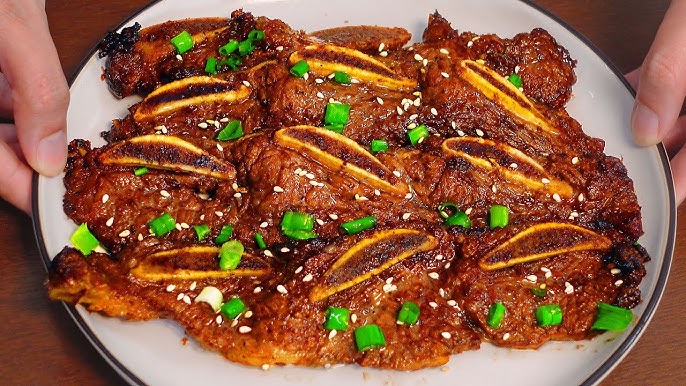Korean Short Rib Recipe: Korean short ribs, known as Galbi or Kalbi, are one of the most beloved dishes in Korean BBQ cuisine. These mouthwatering ribs are famous for their sweet-savory marinade, tender meat, and slightly charred, caramelized edges when grilled to perfection. Unlike traditional American short ribs that are typically braised, Korean short ribs are thinly sliced across the bone, which allows them to soak up more marinade and cook quickly on high heat.
If you’ve ever been to a Korean BBQ restaurant and wondered how to replicate that irresistible taste at home, you’re in the right place. In this guide, we’ll walk you through a foolproof, step-by-step process to make authentic Korean short ribs right in your kitchen. Whether you’re a BBQ lover or a total beginner, you’ll find everything you need right here.
Ingredients You’ll Need
Primary Ingredients for the Short Ribs
To start off, the centerpiece of this dish is, of course, the short ribs. For the most authentic Korean BBQ experience, you’ll need:
- 3 pounds of beef short ribs (flanken cut, about 1/3 inch thick)
- Salt and pepper to taste
The flanken-style cut is crucial—it’s cut across the bone, giving you thin slices with small bone sections in each piece. This type of cut allows the marinade to penetrate deeply and cook quickly over high heat.
Essential Marinade Components
The flavor magic happens in the marinade. This sweet, savory, slightly tangy mixture turns regular beef into an explosion of umami. Here’s what you need:
- 1 cup soy sauce (preferably low sodium)
- 1/2 cup brown sugar
- 1/4 cup honey or rice syrup
- 1/2 cup water
- 1/4 cup sesame oil
- 1 Asian pear (grated) or 1/2 regular pear
- 1 small onion (grated)
- 4 cloves garlic (minced)
- 1 tablespoon ginger (grated)
- 2 tablespoons rice wine or mirin
- 2 teaspoons black pepper
- 2 tablespoons sesame seeds (toasted)
- 3 scallions (sliced for garnish)
Each ingredient plays a vital role. The pear and onion tenderize the meat naturally. Soy sauce adds salt and umami. Brown sugar and honey balance it with sweetness, while garlic and ginger punch in depth.
Choosing the Best Cut of Short Ribs
When it comes to short ribs, not all cuts are created equal. For Korean-style BBQ, always go for flanken-cut beef short ribs, which are sliced thinly across the bones. This cut ensures even cooking and allows the marinade to permeate every nook and cranny. Your local Korean market is the best place to find them, but you can also ask your butcher to slice regular beef ribs in the flanken style if needed.
Avoid thick English-cut ribs for this recipe—they’re better suited for braising. The thin flanken-style ribs grill fast and stay juicy, especially when soaked in a flavorful marinade for several hours.
How to Make the Perfect Marinade
Balancing Sweet, Salty, and Umami Flavors
Creating the perfect marinade is like composing a symphony of flavors. You need the right blend of salty (soy sauce), sweet (sugar, honey), tangy (rice wine), and umami (garlic, onion, sesame oil). One of the unique additions is the Asian pear, which contains enzymes that naturally tenderize the beef. It also adds a subtle fruity undertone without overpowering the flavor.
Here’s the trick: mix all your marinade ingredients in a large bowl until the sugar dissolves completely. You want a smooth, well-blended liquid that will evenly coat the meat. Taste it before adding the ribs—you should feel an initial sweetness, followed by a savory kick, then the depth from garlic and sesame oil.
Tips for Enhancing Depth of Flavor
- Use freshly grated ingredients: Don’t rely on powdered garlic or ginger—fresh is always better.
- Toast your sesame seeds: This brings out a nutty flavor that elevates the dish.
- Let the marinade sit: Allow it to rest for 10–15 minutes before adding meat. This lets the flavors meld together.
- Massage the marinade into the meat with your hands (wear gloves if needed) to make sure every inch is coated.
Step-by-Step Cooking Instructions
Step 1 – Preparing the Ribs
Start by rinsing the flanken-cut short ribs under cold water to remove any bone fragments from the cutting process. Pat them dry with paper towels. This step is crucial for a clean, appetizing final product. Once dry, lay them out flat in a single layer in a large container or zip-top bag.
Now comes the seasoning—sprinkle lightly with salt and pepper before you even touch the marinade. This pre-seasoning helps enhance the beef’s natural flavors and builds the first layer of taste.
Step 2 – Creating the Marinade
In a large mixing bowl, combine all the marinade ingredients and stir until everything is fully dissolved and well blended. Take your time—this isn’t a step to rush. Once the mixture smells aromatic and balanced, pour it over the ribs, making sure each piece is thoroughly coated.
Seal the container or bag tightly, pressing out any extra air, and refrigerate. The longer you marinate, the better the flavor.
Step 3 – Marinating the Ribs (Timing Matters!)
For best results, let the ribs marinate for at least 8 hours, though overnight or up to 24 hours is ideal. This extended soak not only tenderizes the meat but also allows it to absorb that incredible sweet and savory blend deeply. Be sure to flip or massage the ribs a few times during the process so every side gets evenly seasoned.
Step 4 – Grilling or Broiling the Ribs
Now comes the moment of truth—cooking the marinated short ribs. You’ve got a couple of solid options here: grilling or broiling. Grilling over an open flame gives you that authentic Korean BBQ char and smoky flavor, but broiling works well too if you’re cooking indoors.
Grilling Instructions:
- Preheat your grill to medium-high heat.
- Lightly oil the grates to prevent sticking.
- Shake off any excess marinade from the ribs and place them directly on the grill.
- Grill for about 3–4 minutes on each side until nicely browned and slightly caramelized.
- Watch them closely to avoid burning the sugars in the marinade.
Broiling Instructions:
- Set your oven to broil and place a wire rack on a baking sheet.
- Lay the ribs on the rack in a single layer.
- Broil about 4 inches from the heat source for 3–4 minutes per side.
You want the ribs to have those delicious crispy edges but still be juicy inside. Once they’re done, transfer to a serving plate and let them rest for a couple of minutes.
Step 5 – Garnishing and Serving
Presentation matters, especially when you’re making something as impressive as Korean short ribs. Sprinkle the ribs with toasted sesame seeds and sliced green onions. You can even add a little squeeze of fresh lime juice or a brush of sesame oil for extra flair.
Serve the ribs hot alongside steamed white rice, kimchi, pickled radish, or even lettuce leaves if you want to go traditional Korean BBQ-style and wrap them with condiments.
This final touch not only elevates the visual appeal but also adds layers of texture and flavor. The crunch from sesame seeds, the freshness of green onion, and the smoky, savory beef make for a truly unforgettable dish.
Common Mistakes to Avoid
Even the best recipes can go sideways if you’re not careful. Here are a few pitfalls to avoid:
- Using the wrong cut of meat: Flanken-cut is essential. Don’t substitute with thick cuts.
- Skipping the pear or onion: These natural tenderizers are crucial for soft, flavorful meat.
- Under-marinating: Less than 6 hours won’t give you deep flavor. Overnight is best.
- Overcooking: These ribs cook fast. Keep an eye on them to prevent burning.
- Not preheating the grill: You want that immediate sear for flavor and caramelization.
Avoid these, and you’ll be well on your way to mastering Korean short ribs like a pro.
Best Side Dishes to Pair with Korean Short Ribs
No Korean meal is complete without a lineup of delicious side dishes—or banchan. Here are some must-haves:
- Kimchi: Fermented spicy cabbage that adds tang and heat.
- Japchae: Sweet potato glass noodles stir-fried with veggies and soy sauce.
- Pickled radishes: Crunchy and refreshing to balance the richness of the meat.
- Steamed rice: A staple that complements the bold flavors.
- Lettuce leaves and ssamjang (spicy paste): For a fun, interactive wrap.
These sides not only complete your meal but elevate it by providing contrast and variety in taste and texture.
Storage and Reheating Tips
If you have leftovers (though it’s rare with this dish!), here’s how to keep them fresh and tasty:
- Storage: Place cooled short ribs in an airtight container and refrigerate for up to 3 days.
- Freezing: Store in freezer-safe bags for up to 2 months. Thaw overnight before reheating.
- Reheating: Warm in a covered skillet over medium heat or reheat under the broiler for 2–3 minutes per side to retain crispiness.
Try to avoid microwaving if you can—it tends to make the meat chewy.
FAQs about Korean Short Rib Recipe
What cut of meat is best for Korean short ribs?
For authentic Korean-style short ribs, the best cut is beef short ribs—specifically the flanken cut, which is sliced across the bone into thin strips. This cut soaks up marinades beautifully and cooks quickly on a grill or stovetop.
How long should I marinate Korean short ribs?
Ideally, marinate for 12 to 24 hours. The longer the marination, the deeper the flavor. If you’re in a rush, even 4 hours will give you a tasty result, but overnight is chef’s kiss for maximum umami.
Can I cook Korean short ribs without a grill?
Absolutely! While grilling adds smoky flair, you can also pan-sear, broil, or even bake the ribs. Cast iron skillets or grill pans are excellent for achieving that coveted char.
What is Korean short rib marinade made of?
The marinade is a flavor bomb made with soy sauce, garlic, ginger, sesame oil, sugar, green onions, and Asian pear or apple for tenderizing sweetness. It’s savory, sweet, and just a little bit sassy.
Are Korean short ribs spicy?
Traditional Galbi isn’t spicy. It’s more sweet and savory. But hey, if you want to bring the heat, add gochujang (Korean chili paste) or crushed red pepper flakes to the marinade.
Can I freeze marinated Korean short ribs?
Yes! Freeze them in the marinade for a quick future meal. Just thaw overnight in the fridge and cook as usual—flavor stays locked in.
What sides go well with Korean short ribs?
Classic Korean sides like kimchi, pickled radish, steamed rice, japchae, and cucumber salad are perfect pairings. You’re going for that balanced Korean banchan vibe.
How do I know when the ribs are done?
They’re done when nicely charred on the outside and the internal temperature hits about 145°F (63°C) for medium. But honestly, trust your eyes—when they’re caramelized and slightly sticky, you’re good to go.
Can I use pork instead of beef?
Sure! It won’t be traditional Galbi, but pork short ribs or pork belly also taste amazing in the same marinade. Just adjust cooking times since pork can cook faster.
Conclusion
Korean short ribs are more than just a meal—they’re an experience. From the complex marinade to the sizzling grill marks, every step is packed with flavor and fun. By following this step-by-step guide, you’ll not only recreate the magic of Korean BBQ at home but also impress your family and friends with a dish that’s equal parts savory, sweet, and unforgettable.
Whether you’re hosting a dinner party or just want to spice up your weeknight dinner, Korean short ribs are the perfect way to bring people together around good food. Give this recipe a shot, and soon, you’ll be grilling like a Korean BBQ master!



